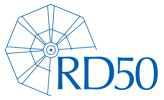Speaker
Description
AC-coupled LGADs, also referred to as resistive silicon detectors (RSDs), rely on a design in which the multiplication layer and n$^{+}$ contact are continuous, and only the metal layer is patterned. In AC-LGADs, the signal is capacitively coupled from the continuous, resistive n$^{+}$ layer over a dielectric to the metal electrodes. The spatial resolution is not only influenced by the electrode pitch, but also the relative size of the metal electrodes. Knowledge of the capacitances of various sensor regions is crucial for understanding charge sharing in the detector, and for providing input for the design of suitable readout electronics.
We have studied the capacitances of the DC and AC contacts, interpad capacitances, and capacitance of the dielectric between the resistive n$^{+}$ layer and top contacts, using AC-LGADs both in small pad array and strip geometries. The impact of measurement parameters, such as serial or parallel mode, grounding of neighboring pads, and frequency will be discussed, while the role of metal electrode size and pitch, as well as n$^{+}$ layer doping, on the detector characteristics is investigated.
